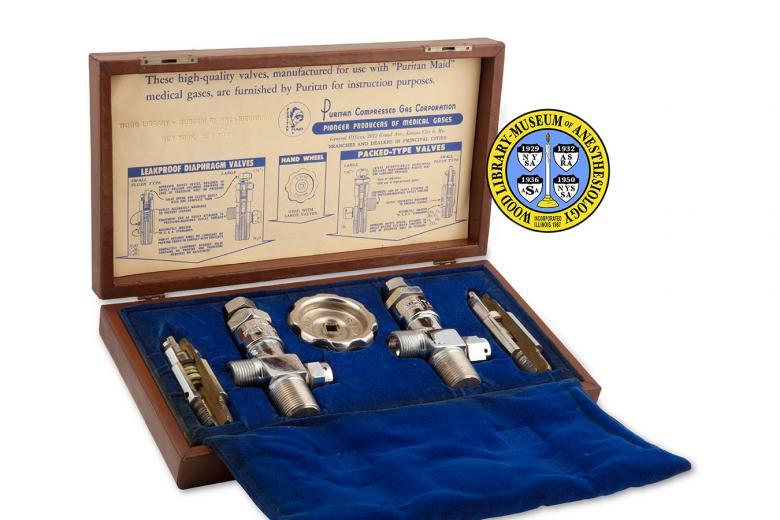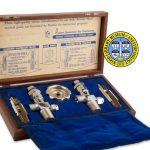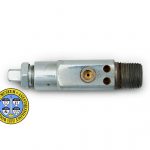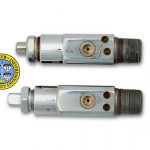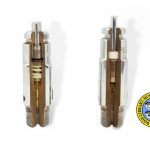Pin Index Valves
Since the 1900s, cylinders of compressed gas have been attached to anesthesia machines by means of a valve, and seated in a bracket or yoke. Until the early 1950s, interchangeable connectors allowed the attachment of any gas to any yoke. Despite color-coded cylinders, this also made it possible to connect the wrong gas. The National Fire Protection Association, the Compressed Gas Association, and American Society of Anesthesiologists worked together to eliminate that risk.
The resulting Pin Index Safety System was introduced in 1952, and led to an international standard. The system requires each cylinder valve and each yoke to be made for use with only one, specific gas. Pins in the yoke correspond to matching holes in the valve, so that a cylinder indexed for one gas (such as nitrous oxide) cannot be connected to a yoke indexed for any other gas (such as oxygen). This helps to ensure that the patient under anesthesia is never without oxygen to breathe.
The system was implemented in stages over several years; old cylinder valves were recalled, and adapters allowed the conversion of existing yokes. The system is still used today and is just one of a number of standards created to ensure safety for patients receiving anesthesia care. In 1956, this demonstration set of pin indexed valves was donated to the Wood Library-Museum by the manufacturer, Puritan Compressed Gas Corporation.
Catalog Record: Pin Index Valves
Access Key: akiu
Accession No.: 1956-03-15-1
Title: Puritan Compressed Gas Corporation [set of gas valves].
Corporate Author: Puritan Compressed Gas Corporation.
Title variation: Alt Title
Title: Pin Index Valves.
Title variation: Alt Title
Title: Puritan Maid [case with cutaway gas valves].
Title variation: Alt Title
Title: Set of two diaphragm valves and two packed valves.
Publisher: Kansas City, Mo. : Puritan Compressed Gas Corporation; [1953-1956].
Physical Descript: 1 set of valves ; metal, textile, vinyl, Teflon, paper : 5.5 x 30 x 16.5 cm.
Subject: Gases, Compressed – instrumentation.
Subject: Gases, Medical – instrumentation.
Note Type: General
Notes: Title is cataloger constructed and based on the Puritan Compressed Gas
Corporation logo on the outside of the case and on text on the label inside
of the case. The early date (1953) in the date range for the possible year of
manufacture is based on the year that the Compressed Gas Association set the
standard for the Pin Index Safety System. The end date is based on the year
that the set was donated to the Wood Library-Museum of Anesthesiology. The
date range could change if documentation indicates the range should be
corrected.
Note Type: Citation
Notes: Boatright J, Ward JJ. Therapeutic gases: manufacture, storage, and delivery.
In: Hess DR, MacIntyre NR, Mishoe SC, Galvin WF, Adams AB, eds. Respiratory
Care: Principles and Practice. 2nd ed. Sudbury, MA: Jones & Bartlett
Learning; 2012:254-267.
Note Type: Citation
Notes: Celebrating 100 Years as the Standard for Safety: The Compressed Gas
Association, Inc. 1913-2013. Chantilly, VA: Compressed Gas Association;
2013:27-33. https://www.cganet.com/100th-anniversary-review.php. Accessed
September 6, 2013.
Note Type: Citation
Notes: Dorsch JA, Dorsch SE. Medical gas cylinders and containers. In: Understanding
Anesthesia Equipment. Philadelphia: Wolters Kluwer/Lippincott Williams &
Wilkins; 2008:2-4.
Note Type: Citation
Notes: Foreword. Standard for compressed gas cylinder valve outlet and inlet
connections: CGA V-1–2013 [preview]. 13th ed. Chantilly, VA: Compressed Gas
Association; 2013: viii-ix.
Note Type: Citation
Notes: Hickcox CB. Ralph Moore Tovell, M.D. 1901-1967. Anesth Hist Assoc Newsl. July
1989;7(3):1, 4-7.
Note Type: Citation
Notes: Jacob AK, Kopp SL, Bacon DR, Smith HM. The history of anesthesia. In: Barash
P, Cullen BF, Stoelting RK, Cahalan M, Stock MC, Ortega R. eds. Clinical
Anesthesia. 7th ed. Philadelphia: Wolters Kluwer/Lippincott Williams &
Wilkins; 2013:13.
Note Type: Citation
Notes: Pin-Index Safety System for Flush-type Cylinder Valves. New York: Compressed
Gas Association; 1952.
Note Type: Citation
Notes: Rendell-Baker L. History of development of standards for anesthesia equipment
In: Rupreht J, van Lieburg MJ, Lee JA, Erdmann W. Anaesthesia: Essays on Its
History. Berlin: Springer-Verlag;1985:161-165.
Note Type: Citation
Notes: Tovell RM. Problems in supply of anesthetic gases in the European theater of
operation, U. S. Army. Anesthesiology. 1947;8(3):303-311.
Note Type: Citation
Notes: Tovell RM. Safety measures adopted for medical gases. ASA Newsl.
1952;16(3):4-8.
Note Type: Physical Description
Notes: One set of two cutaway diaphragm valves for compressed gas cylinders, two
cutaway packed valves for compressed gas cylinders, and one hand wheel for
large valves; These are packed in a flat wooden case that is covered in brown
vinyl; The inside of the case is cushioned and lined with blue velvet; Marked
on the vinyl on the top of the case in the center is the Puritan logo
(PURITAN MAID); Marked in the right lower corner of the top of the case is
“NO. PMCK”; One of the diaphragm valves is of the “small flush type” and the
other is “large”; One of the packed valves is of the “small flush type” and
the other is “large”; All of the valves are marked with, “PURITAN”; The hand
wheel for use with “large valves” is marked with “PURITAN” on one side, and
“GASES” on the other side; The small diaphragm cylinder valve is made with
the Pin Index Safety System pattern of holes for cyclopropane; “C3H6” is
marked on the side of the valve with the holes; The small packed cylinder
valve is made with the Pin Index Safety System pattern of holes for oxygen;
O2 is marked on the side of the valve with the holes; The large valves have
outlets that appear to conform to an early edition of the American Standard
Safety System; A paper label is glued to the inner side of the lid; At the
top of the label in large lettering is, “These high-quality valves,
manufactured for use with “Puritan Maid” medical gases, are furnished by
Puritan for instruction purposes.”; On the left side of the label, in gold
colored print, is, “WOOD LIBRARY – MUSEUM OF ANESTHESIOLOGY [new line] NEW
YORK, NEW YORK”; The Puritan logo (Puritan Maid) is in the center of the
label; On the right side of the label is, “Puritan Compressed Gas Corporation
[new line] PIONEER PRODUCERS OF MEDICAL GASES [new line] General Offices,
2012, Grand Ave., Kansas City 8, Mo. [new line] BRANCHES AND DEALERS IN
PRINCIPAL CITIES”; On the left lower side of the label is a diagram of the
two diaphragm valves, titled, “LEAKPROOF DIAPHRAGM VALVES”; On the lower
center of the label is a labeled illustration of the hand wheel; On the right
lower side of the label is a diagram of the packed valves, titled,
“PACKED-TYPE VALVES”.
Note Type: Reproduction
Notes: Photographed by Mr. Steve Donisch on January 17, 2013.
Note Type: Acquisition
Notes: Donated to the WLM by the Puritan Compressed Gas Company.
Note Type: Historical
Notes: Medical gases, such as oxygen and nitrous oxide, are supplied to the
anesthesia machine from a piped gas system or from metal cylinders. The
cylinders are constructed to store gas under high pressure, and the valves
both seal the contents and are the mechanism for opening and closing the
cylinders. There are two functional-types of valves used on medical gas
cylinders, diaphragm and packed valves. The set described here contains two
examples of each. The valves have been machine cut to expose the functional
parts inside. Smaller cylinders that are connected directly to anesthesia
machines and used with portable ventilators are topped by the smaller valves.
These smaller valves include another feature that is primarily one of safety:
the pin index.
The Pin Index Safety System was developed through a combined effort of
representatives from the National Fire Protection Association, the Compressed
Gas Association, and American Society of Anesthesiologists, and was
introduced in 1952. All anesthesia machines in the United States were
required to conform to the standard by January 1, 1957. It was created to
prevent one gas from being connected to the anesthesia machine at a port
meant for a different gas. It is especially important to place only oxygen
cylinders on the oxygen port so that a patient under anesthesia is never
without oxygen to breathe. This system is still used today and is just one of
a number of standards created to ensure safety for patients receiving
anesthesia care.
The standard works by assigning each medical gas a unique pair of pins that
protrude from the point of connection on an anesthesia machine. Like pared
puzzle pieces, holes in the cylinder valves of one gas match only the pins in
the connections made for that gas. Thus, only cylinders of oxygen fit an
anesthesia machine at the pin-indexed connection for oxygen, and only
cylinders of nitrous oxide fit the pin-indexed connection for nitrous oxide.
One of the small cylinder valves in the set described here has the pattern of
pin holes for cyclopropane (C3H6), and the other has the pattern of holes for
oxygen (O2).
Anesthesiologist, Ralph M. Tovell (1901-1967) was an early advocate for
national and international anesthesia equipment standards. He first voiced
concern and made recommendations for international standards as a Colonel in
the US Army during World War II. Dr. Tovell was an American Society of
Anesthesiologists representative to the group that developed the Pin Index
System.
The larger valves in this set are for cylinders that hold large volumes of
compressed gas. The outlets on these valves conform to an early version of
the American Standard for Compressed Gas Cylinder Outlet and Inlet
Connections (or American Standard Safety System for short). Work on this
system was started by the Compressed Gas Association and first widely
introduced in 1949. It was further defined with input from additional
organizations including the American Society of Anesthesiologists and
published in 1965. Since then it has been updated every few years to address
industry wide-changes.
Note Type: Publication
Notes: Davis HS, Kretchmer HE. Progress in standardization of anesthesia apparatus.
Anesth Analg. 1959;38(2):85-93.
Note Type: Publication
Notes: Grove DD, Covintree GE. Precaustions with gases used by the anesthesiologists
(exclusive of fire and explostion hazards). Anesth Analg. 1953;32(3):145-158.
Note Type: Publication
Notes: Medical gas: a new safety measure. Br J Anaesth. 1955;27(10):515-516.
Note Type: Exhibition
Notes: Chosen for the WLM website (noted August 28, 2013).
